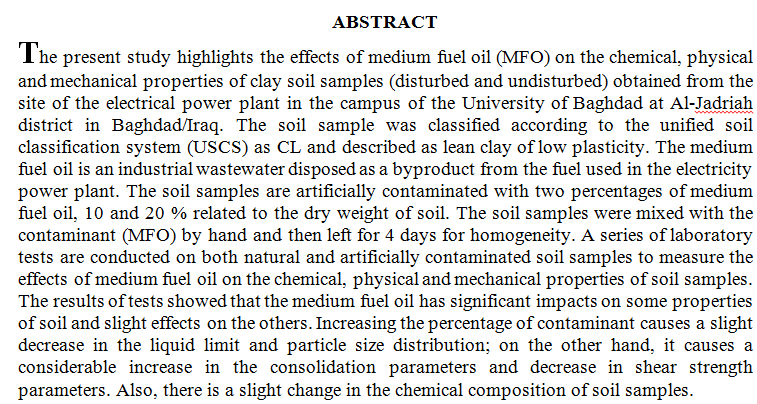
Films of pure Poly (methyl methacrylate) (PMMA) doped by potassium iodide (KI) salt with percentages (1%) at different thickness prepared by casting method at room temperature. In order to study the effect of increasing thickness on optical properties, transmission and absorption spectra have been record for five different thicknesses(80,140,210,250,320)µm. The study has been extended to include the changes in the band gap energies, refractive index, extinction coefficient and absorption coefficient with thickness.
The Dielectric properties of EP/TiO2 and MgO nanocomposite at
a frequency range of (102-106 Hz) were studied. The composite were
prepared with the state volume ratio (0, 0.05, 0.1) for EP/TiO2 and
MgO respectively. The impedance, dielectric constant and dielectric
loss were found decrease with frequency increase.
The liver protective effects of pentoxifylline were studied through pre-treatment of rats with various intraperitoneal (IP) doses (25, 50 and 100mg/kg/day) 14 days before induction of liver toxicity by carbon tetrachloride (CCl4). The parameters of oxidative stress, malondialdehyde (MDA) and reduced glutathione (GSH) were measured in liver homogenate in addition to histopathological examinations. Analysis of data revealed significant amelioration of oxidative stress in groups of animals pre-treated with different doses of pentoxifylline (PTX) compared to group of animals intoxicated by CCl4 as evidenced by lowering MDA contents and elevation of GSH levels in liver tissue homogenate but the levels still signifi
... Show More (5)
(5)
Six isolates of Bacillus thuringiensis were isolated from Iraqi soil characterized as non- insecticidal and non- hemolytic parasporal inclusion proteins. Bacterial isolates were propagated on nutrient broth. Then, the parasporal inclusion proteins were extracted and processed with proteinase K and trypsin. The major protein segments produced of 64KDa were characterized and tested for cytocidal activity against human leukemic T- cells (CLL) (Chronic lymphoid leukemia). Results indicated that the treated parasporal proteins of four isolates (Bt2, Bt3, Bt4 and Bt6) showed strong cytotoxicity with no significant differences between normal lymphocytes and leukemic lymphocytes. Two isolates BtA1 and BtA5 show discriminative cytotoxicity between n
... Show More (3)
(3)
 (1)
(1)
Abstract
Nephrotoxicity is defined as rapid deterioration in kidney functions. It arises from direct exposure to drugs or their metabolites. Methotrexate is a famous chemotherapeutic drug with anti-inflammatory and immunosuppressive properties. A high-dose methotrexate-induced renal dysfunction can be life threatening. Cyanocobalamin, one of the forms of vitamin B12, acts as a coenzyme in the conversion of homocysteine to methionine in the cytosol, and the conversion of methylmalonyl-CoA to succinyl-CoA in the mitochondrion. This study is designed to examine the effect of cyanocobalamin in two different doses each co-administered with methotrexate at 20 mg/kg induced nephrotoxicity in rat
... Show More (1)
(1)
 (3)
(3)
 (35)
(35)
 (38)
(38)
It is found that hypersensitive teeth have a larger number and wider patent tubules than those of non-sensitive teeth. Objective: The aim of this study is to compare between the effects of diode laser at different power densities, with and without sodium fluoride on the sealing of exposed dentinal tubules and dentin permeability. Materials and methods: 118 teeth were used. Samples were divided into three major groups. The first consisted of 100 teeth used for permeability test. The second consisted of 16 teeth for measuring external surface temperature elevation while irradiation. The third, in turn, consisted of one pair of teeth observed under SEM for dentine surface morphology analysis. Results: For dentin permeability measurement, th
... Show MoreBackground: Masseter muscle is one of the most obvious muscles of mastication and considered as one indicator of jaw muscle activity. It has a major influence on the transverse growth of the midface and the vertical growth of the mandible. This study undertaken to determine the role of cephalometric analysis for discrimination between Cl I and Cl III skeletal relationships, determine the role of ultrasonography in determination of masseter muscle thickness, compare masseter muscle thickness between Cl I and Cl III skeletal relationships, and determine the effect of gender on masseter muscle thickness. Material and Method: The sample of the current study consisted of 70 Iraqi subjects 40 males and 30 females with age ranging 18-25 years. The
... Show More (1)
(1)
Abstract
Sovereign wealth funds are an important tool for achieving economic stability and avoiding the local economy from external shocks, including the shocks of international oil prices. The spread of these funds is the result of large current account surpluses in many Asian and oil-exporting economies. These surpluses are due to higher commodity prices Has led to a rapid accumulation of foreign assets in central banks. Many countries with rent economies face the problem of their dependence on non-renewable natural resources, especially the oil countries, including Iraq. Oil revenues are more than 97% of oil exports, so they suffer from structural imbal
... Show More (1)
(1)
The Carbonate-clastic succession in this study is represented by the Shuaiba and Nahr Umr Formations deposited during the Albian - Aptian Sequence. The present study includes petrography, microfacies analyses, and studying reservoir characterizations for 5 boreholes within West Qurna oil field in the study area. According to the type of study succession (clastic – Carbonate) there are two types of facies analyses:-Carbonate facies analysis, which showed five major microfacies were recognized in the succession of the Shuaiba Formation, bioclastic mudstones to wackstone, Orbitolina wackestone to packstone, Miliolids wackestone, Peloidal wackestone to packstone and mudstone to wackestone identified as an open shelf toward the deep basin.
... Show More